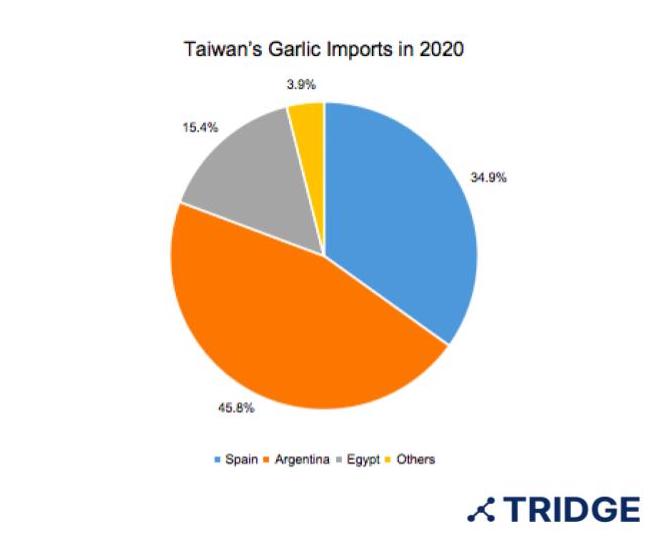What caused the garlic shortage in the Taiwanese market?
Taiwan imported a total of 18.8 thousand metric tons of garlic worth USD 16.94 million in 2020. Shelly Chen, Regional Manager of Tridge in Taiwan, informs that domestically produced garlic will last for six months from the main harvest season, March-April. The domestic garlic demand is about 60 thousand tons per year, and 33% of consumed garlic is fulfilled through imports. The country mainly imports garlic from Argentina, Spain, and Egypt, which had a share of 45.8%, 34.9%, and 15.4% respectively in Taiwan’s garlic imports in 2020.

Source: Tridge. HS Code:070320
Argentina, Spain, and Egypt have different harvest and export seasons, supporting Taiwan’s import demand for garlic all year round. Garlic season starts in Argentina during November and lasts till July, during which its exports to Taiwan peaked. While garlic season in Spain and Egpyt starts from June and goes up till December. Due to the seasonality, the majority of the imports during the first half of 2020 were from Argentina, while the exports from Egypt and Spain picked up the pace and peaked in June during the second half.

Source: ITC. Trade Map. HS Code: 070320.
Taiwan has recently implemented new regulations and conditions to import garlic, as the rejection rate has become very high at the customs clearance recently. Since the beginning of the garlic import season 2021, more than ten containers of garlic have been rejected by the customs due to soil remnants found on garlic from Spain and Egypt. Traders and importers in Taiwan are looking to import garlic from Argentina to cover up for the reduced imports from other sources. As the harvest season for Argentina garlic ends soon, the import volume has fallen to zero between June and August.
As a result, the ending seasonality of Argentinian garlic and the high rejection rate of garlic from Spain and Egypt caused garlic shortage issues in the domestic market in Taiwan. Shelly reported that garlic prices in Taiwan reached a record high in April 2021, about 30% more than the price recorded last year. It is expected that the garlic shortage in Taiwan will continue in the coming months, further increasing the pressure on already inflated prices.
Sources
- Fresh Plaza. "I expect garlic exports this season to increase by 30%."
- ITC Trade Map. HS Code:070320.
- Tridge. Local Insights. "Taiwan garlic importer favors Argentina garlic in season 2021 due to quality concerns."



